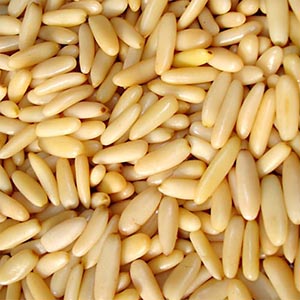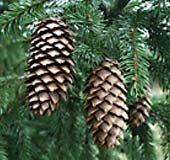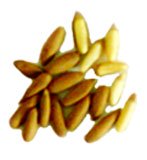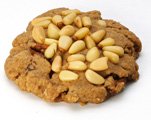Pine nuts Nutrition facts
Crunchy yet buttery textured, pleasantly sweet, and delicious, pine nuts are small edible seeds (kernels) of the female cone on a pine tree. Pine kernels are indeed a splendid source of plant-derived nutrients, essential minerals, vitamins, and "heart-friendly" monounsaturated fatty acids that significantly benefit health by reducing bad cholesterol levels in the blood.
Botanically, pines belong to the family Pinaceae, in the genus Pinus. Some of the common names are pinon nuts, pignoli, cedar nuts, chilgoza, pinyon pinenuts, etc.
 |
| Pine nut kernels. |
Pine trees are primarily found in the cold and taiga forests of the northern hemisphere, particularly in Siberia and Canada. They are towering, straight, and erect trees with large stems that can reach heights of up to 75 feet and boast a pyramidal or umbrella-like canopy of dense foliage cover.
The "flowers" subsequently develop into cones. The female cones take up to three years to mature after pollination. At maturity, they (ovulate or seed cones) may range from as small as 3 cm long to a very large size, reaching up to 35 cm. Cone scales near the base and tip ends tend to be small and sterile, and therefore, bear no seeds. Once mature and dry, the cone naturally splits open to release the edible pine kernel.
The two prominent pine species known for their large edible kernels include Pinus sibirica and Pinus koraiensis. Western (stone) pines have long slender kernels compared to the Oriental pines, in which the seeds are broad, large, and possess a higher fat content.

|

|
| Pine cones hanging on a pine branch. (Photo: Let ideas) | Chilgoza pine nuts and kernels. |
Pine nuts are characterized by a tough dark-brown outer coat (shell). Inside, the edible kernel is cream-white, boasting a delicate buttery flavor and a pleasantly sweet taste.
Chilgoza pine nut (Pinus gerardiana) is another distinctive pine variety found in the western Himalayan forests of Pakistan, India (Kashmir, Himachal Pradesh), and Afghanistan. Chilgoza pines share a similar appearance with stone pines, showcasing long slender, pointed kernels.
Health Benefits of Pine Nuts
Pine nuts are one of the calorie-rich edible nuts. 100g of dry kernels provide 673 calories. Additionally, they comprise numerous health-promoting phytochemicals, vitamins, antioxidants, and minerals.
Their high caloric content chiefly comes from fats. Indeed, the nuts are especially rich in monounsaturated fatty acids like oleic acid (18:1 undifferentiated fat), which help to lower LDL or "bad cholesterol" and increase HDL or "good cholesterol" in the blood. Research studies suggest that the Mediterranean diet, which contains useful amounts of monounsaturated fatty acids, vitamins, and antioxidants, helps to prevent coronary artery disease and strokes by favoring a healthy blood lipid profile.
Pine or cedar nuts contain the essential fatty acid (the omega-6 fat), pinolenic acid. Recent research has shown its potential use in weight loss by curbing appetite. Pinolenic acid triggers the release of hunger-suppressant enzymes cholecystokinin and Glucagon-like peptide-1 (GLP-1) in the gut. Also, pinolenic acid is thought to have LDL-lowering properties by enhancing hepatic LDL uptake.
Similarly to almonds, pine nuts are an excellent source of vitamin E, composing about 9.33 mg per 100g (about 62% of RDA). Vitamin E is a powerful lipid-soluble antioxidant required for maintaining the integrity of the cell membrane of mucosa and skin by protecting it from harmful free oxygen radicals.
Furthermore, pine nuts are one of the gluten-free tree nuts and therefore are a popular ingredient in the preparation of gluten-free food formulas. Such formula preparations can be a healthy alternative in people with wheat food allergy and celiac disease.
Pine nuts are an excellent source of the B-complex group of vitamins such as thiamin, riboflavin, niacin, pantothenic acid, vitamin B-6 (pyridoxine), and folates. These vitamins work as co-factors for enzymes in cellular substrate metabolism inside the human body.
Additionally, pine nuts contain healthy amounts of essential minerals like manganese, potassium, calcium, iron, magnesium, zinc, and selenium. At 8.802 mg per 100g (about 383% of the daily recommended intake), pine nuts are one of the richest sources of manganese. Manganese is an all-important co-factor for the antioxidant enzyme, superoxide dismutase. Therefore, the consumption of pine kernels helps the human body develop resistance against infectious agents and scavenge harmful oxygen-free radicals.
Pine nut oil has a delicate flavor with a sweet aroma and is used in many traditional medicinal remedies. The main chemical components in pine oil are borneol, bornyl acetate, a and ß-phellandrene, a-pinene, and ß-pinene. Its emollient property helps to keep the skin well protected from dryness. It has also been employed in cooking and as a "carrier or base oil" in traditional medicines and aromatherapy, in the pharmaceutical and cosmetic industry.
| Principle | Nutrient Value | Percent of RDA |
|---|---|---|
| Energy | 673 Kcal | 34% |
| Carbohydrates | 13.08 g | 10% |
| Protein | 13.69 g | 24% |
| Total Fat | 68.37 g | 228% |
| Cholesterol | 0 mg | 0% |
| Dietary Fiber | 3.7 g | 10% |
| Vitamins | ||
| Folates | 34 µg | 9% |
| Niacin | 4.387 mg | 27% |
| Pantothenic acid | 0.313 mg | 6% |
| Pyridoxine | 0.094 mg | 7% |
| Riboflavin | 0.227 mg | 17% |
| Thiamin | 0.364 mg | 30% |
| Vitamin A | 29 IU | 1% |
| Vitamin C | 0.8 mg | 1% |
| Vitamin E | 9.33 mg | 62% |
| Electrolytes | ||
| Sodium | 2 mg | 0% |
| Potassium | 597 mg | 13% |
| Minerals | ||
| Calcium | 16 mg | 1.5% |
| Copper | 1.324 mg | 147% |
| Iron | 5.53 mg | 69% |
| Magnesium | 251 mg | 63% |
| Manganese | 8.802 mg | 383% |
| Phosphorus | 575 mg | 82% |
| Selenium | 0.7 µg | 1% |
| Zinc | 6.45 mg | 58% |
| Phyto-nutrients | ||
| Carotene-ß | 17 µg | -- |
| Crypto-xanthin-ß | 0 µg | -- |
| Lutein-zeaxanthin | 9 µg | -- |
Selection and Storage
In the wild, the seeds that fall to the ground are typically gathered and processed. In markets, one can find both shelled and unshelled pine nuts available for sale.
When purchasing whole unshelled nuts, look for those with a bright brown color, compactness, uniform size, heaviness in hand, and a good metallic sound when dropped from a height. They should be free from cracks, mold, spots, and rancidity.
Shelled and processed kernels are also sold in airtight plastic bags in stores. Always opt for fresh pine kernels from reliable sources.
Unshelled nuts have a long shelf life and can be stored for many months. Shelled kernels degrade quickly if exposed to light, heat, and humidity. Therefore, store shelled nuts in airtight jars and keep them in the refrigerator.
Preparation and Serving Methods
Raw whole pine nuts are typically split open at processing units using larger sheller machines. Smaller nut sheller equipment or handheld pliers are commonly used at the domestic level.
Here are some serving tips:

|
| Pine nut cookie. |
Siberian pines are generally enjoyed as they are. Additionally, they can also be eaten roasted, salted, or sweetened.
They are also used in granolas, biscuits, cookies, chocolates, and crunchy energy bar preparations.
The nuts are also used in salads, especially sprinkled over fruit or vegetable salads.
Pinon nuts are used in desserts, particularly sundaes and other ice cream or confectionary-based recipes.
They frequently feature in meat, fish (halibut with a pine nut crust), and vegetable dishes.
Pine nut oil is used in salad dressing and cooking.
Safety Profile
There are several reported cases of altered taste perception (cacogeusia or pine mouth) following pine nut consumption. It appears a few days after eating the nuts and may persist for up to a week. However, Pine mouth is a self-limited condition and resolves on its own without any sequelae.
Pine nut allergy may occur in some sensitive individuals. The reaction symptoms may range from simple skin itching (hives) to severe forms of anaphylactic manifestations, including difficulty breathing, abdominal pain, vomiting, and diarrhea. Cross-reactions may also occur with some other nuts and fruits, especially members of the Anacardiaceae family such as mango, cashew nuts, pistachio, etc. Persons with known allergic reactions to these nuts may, therefore, need to observe caution while eating them. (Medical disclaimer).
≺≺ Back to Nuts and seeds from Pine nuts. Visit here for an impressive list of nuts and seeds with complete illustrations of their nutrition facts and health benefits.
≺≺ Back to Home page.
Further Reading and Recommendations:
Pinyon pine trees-DesertUSA.
NSW Food Authority. pdf